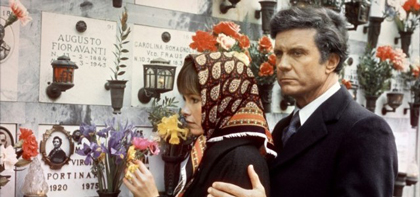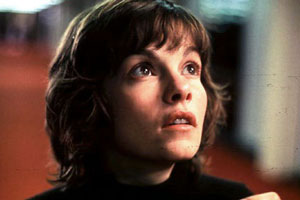
 |
|
|
|
In the later 1970s Brian De Palma's movies descended into full-on voyeur mode, as if his personal obsession with Alfred Hitchcock had evolved into some kind of creative disease. Ten years before, De Palma's often brilliantly constructed movies showed as much if not more promise than either Francis Coppola or Martin Scorsese. In his most fertile period, De Palma fell into the mode of parroting Hitchcock's films, right down to situations, camera angles, and mechanical gimmicks. Sisters intentionally catalogued Hitchcock touches but did so with boundless creative energy. The same can be said for Obsession, a feature-length hommage to Vertigo, originally entitled Déjà vu. 
Worked out with screenwriter Paul Schrader, the pretzel-like story reproduces the major elements of Vertigo. New Orleans real estate developer Michael Courtland (Cliff Robertson) suffers a terrible loss when his wife Elizabeth (Geneviève Bujold) and daughter are killed in a bungled kidnapping. He blames himself for following the police strategy of substituting plain paper for the expected ransom. Fifteen years later, encouraged by his business partner Robert Lasalle (John Lithgow), 'Court' returns to Italy and revisits the same Florentine church where he met his long-lost wife ... and finds there a doppelgänger in Sandra Portinari (also Geneviève Bujold), a young Italian art restoration worker. Court becomes compelled to transform Sandra into the image of Elizabeth. Savant is aware that many Hitchcock fans and Bernard Herrmann followers do not like Obsession. Personally, I was floored by the film when it came out in the Bicentennial year. It played like opera. I was yet another film student crazy about Bernard Herrmann, and his overpowering score was the movie, almost as if the film's emotions had been composed first as music and the images directed to fit. The fact that the story was a reworking of Vertigo was no detriment; in 1976 Hitchcock's movie had been withdrawn from all exhibition, and I was totally obsessed with it. 1 De Palma's Phantom of the Paradise had been merely okay, neither as funny nor as clever as it thought it was. The crass Carrie I never liked at all. But I was utterly transported by Obsession, a full-blown melodramatic tour-de-force of wild noir gimmicks and unrestrained emotions. De Palma alternates between starry-eyed close-ups of his leads and smooth moving-camera shots. There's only one instance where his camera direction stumbles, in a Florentine cafe where he executes ping-pong pans back and forth between talking heads. In the story's high-pitched, hyped emotional context, even the double-turntable circular dance shot, the Hitchcock 'gimmick' cribbed from Vertigo, seems appropriate. 
(spoilers, big ones, until the big * further down the column.) Obsession isn't so much a remake as it is a transposition. The romance is so intensely observed that I've never really analyzed the plot. The John Lithgow character clearly conspires against Robertson, but I don't know how that scheme is supposed to benefit him, or why he confesses all to his patsy. With its near-heavenly reunion of father and child, the picture is also an emotional answer to The Searchers. Schrader was one of the 1970s crop of young filmmakers intrigued by the Ford film. His script is full of sly jokes, such as one of the first words out of Sandra's mouth being 'Dadi' - 'Daddy.' Schrader and De Palma reference the legend of Dante and Beatrice, adding another level of romance stuck in time. Courtland recreates Elizabeth in Sandra as Hitchcock's Scotty recreated Madeline in Judy. In this case Courtland's obsession is to resurrect a lost Eden of marriage and happiness. For '70s types like Savant, this has further resonances -- Robertson was mildly associated with JFK through a previous movie role. We spent a couple of decades fantasizing some kind of utopian Camelot that might have come to pass had Kennedy not been assassinated. Appropriately subdued, Cliff Robertson never loses our sympathy as the deranged Michael,. Ms. Bujold takes the acting honors, turning more than one moment into a classic. De Palma and editor Paul Hirsch's airport flashback owes nothing to Hitchcock. Its 'bravura' cutting suits the scene perfectly, but the focus is on the amazing Geneviève, who is seen transforming into a child without a cut, in one very accomplished shot. The talented newcomer John Lithgow is pompous and puffy as the oily LaSalle. Lithgow seems to have been ready to play any extreme role from the very beginning of his career. I think at one point, while pinned to his own desk by Robertson, he's channeling the distinctive delivery of Hans Conreid. 
The docu on the disc digs deeply into the preproduction evolution of De Palma's original script. A (really far-fetched) fourth act was eliminated entirely, in which the kidnap scenario would be replayed once more after Courtland's release from prison ... he did kill his business partner in anger, remember. This coda didn't make it to filming and it doesn't sound like a good idea, as Obsession already asks the viewer to buy far too many strange contrivances, and the hoary 'psychological shock cure' gag has rarely worked in movies. The docu's big revelation is that the movie was finished with Michael not just dreaming about marrying Sandra, but actually marrying and sleeping together. Apparently somebody drew the line at allowing the two stars to commit an act of incest, and apparently be happy about it later. The idea of moving heaven and Earth to revive a dead lover, and getting a daughter instead, makes for an ending that is already bizarre and emotionally mixed. 2 (spoiler) To de-incest the film (cheat, detractors would say), an optical was added to render the wedding scenes as a dream of the possibly drugged Courtland. The show was remixed to hide the changes, but there remains an audio transition that until now has always stood out like a sore thumb. When Sandra returns from Elizabeth's tomb, Courtland sweeps her in his arms. The picture dissolves to a tilt up the side of an office building. On film and in earlier video incarnations, the Herrmann score rises in intensity, and then makes an abrupt and awkward change. The newer remix track drops out the music, smoothing the transition somewhat. This rising note probably led into the deleted original 'real' marriage scene. The older Columbia Tristar DVD from 2001 retains the original mono track that has the abrupt music change from the theatrical track. * Arrow Video's Blu-ray of Obsession, a region-free disc that plays on normal U.S. players, is well worth ordering from Amazon UK. The HD transfer is an improvement not only on previous DVD releases, but also on the majority of theatrical release prints from 1976. I saw Obsession first-run on Hollywood Blvd, and can testify that release prints were a bleary, smeary, grainy, greenish mess. Cinematographer Vilmos Zsigmond's ill-conceived photographic style starts from a baseline where everything is diffuse and colors are subdued. The 70s were the age of filter effects, and what might have looked good in the original photography did not dupe well, not at all. Add to Zsigmond's thick filters more optical mush for the dream sequences, and the visuals simply disintegrated as dupe prints were made. This soft imaging also played havoc with home video DVD mastering. Scenes with fog, etc, normally require extra video finesse to avoid looking out of focus. On early video presentations Obsession looked as if it had been printed on warm wax ... or as if someone had smeared your monitor screen with Vaseline. 
The Arrow Blu-ray cuts through all of these duplication problems to reveal that Obsession started out as an attractive movie. We can now see that Zsigmond had in mind a beautiful soft visual effect, which was not practical in 1976. Printing techniques for release prints destroyed his delicate effects and cheap lab work soaked it all in a monotonous greenish hue. The filmmakers that raved about Zsigmond's talent must have been evaluating first-generation prints off the original negative. This UK Blu-ray is a big improvement on all previous copies of the film. Colors pop out where none had been visible before, and previously bland and murky images in Florence now look magical. The picture no longer looks excessively grainy; areas of the screen in soft focus are far more natural. Visually, Obsession is now reborn. Arrow's disc comes packed with fine extras, starting with the excellent Laurent Bouzereau docu on the film's genesis from the earlier Sony disc. Next come two of De Palma's early films, known to most film students only as titles: Woton's Wake and The Responsive Eye. The film's trailer is here as well. Even more desirable, Arrow has included the entire original script for Obsession by Paul Schrader entitled Déjà vu. A new booklet contains an essay by Brad Stevens. Arrow finishes with its customary extras -- a reversible cover with four different original poster designs, and a foldout poster with two more advertising designs. None use the original American "Rorschach test" graphic.
On a scale of Excellent, Good, Fair, and Poor,
Obsession rates:
Footnotes:
1. Vertigo was almost completely out of circulation for the entire decade of the '70s. Filmex had shown it in 1971, and we were knocked down by its Technicolored power. The County Museum of Art showed it once in 1974, and judging by De Palma's comments on this disc's docu, De Palma and Schrader may have been in the audience with me. For the record, the other two films that were virtually un-seeable in the middle 1970's and therefore grew to immense proportions in Savant's imagination were Eyes Without a Face and The Seventh Victim.
2. (spoiler) The last time Savant paid attention to idiotic television reviewers was with this film. The NBC Los Angeles critic dismissed and spoiled the picture in three or four sentences. He laughed at the camera and even said out loud, "...and you won't believe it, she turns out to be his daughter!" I wanted to smash the television. Luckily I'd seen the movie the night before.
Reviews on the Savant main site have additional credits information and are often updated and annotated with reader input and graphics. Also, don't forget the 2011 Savant Wish List. T'was Ever Thus.
Review Staff | About DVD Talk | Newsletter Subscribe | Join DVD Talk Forum |
| ||||||||||||||||||